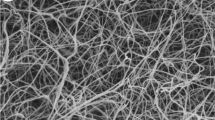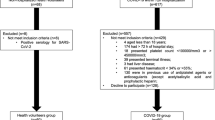Abstract
Objective
Atrial fibrillation (AF) is a condition where platelet hyperaggregability is commonly present. We examined potential physiological bases for platelet hyperaggregability in a cohort of patients with acute and chronic AF. In particular, we sought to identify the impact of inflammation [myeloperoxidase (MPO) and C-reactive protein (CRP)] and impaired nitric oxide (NO) signaling.
Methods
Clinical and biochemical determinants of adenosine diphosphate (ADP)-induced platelet aggregation were sought in patients (n = 106) hospitalized with AF via univariate and multivariate analysis.
Results
Hyper-responsiveness of platelets to ADP was directly (r = 0.254, p < 0.01) correlated with plasma concentrations of thrombospondin-1 (TSP-1), a matricellular protein that impairs NO responses and contributes to development of oxidative stress. In turn, plasma TSP-1 concentrations were directly correlated with MPO concentrations (r = 0.221, p < 0.05), while MPO concentrations correlated with those of asymmetric dimethylarginine (ADMA, r = 0.220, p < 0.05), and its structural isomer symmetric dimethylarginine (SDMA, r = 0.192, p = 0.05). Multivariate analysis identified TSP-1 (β = 0.276, p < 0.05) concentrations, as well as female sex (β = 0.199, p < 0.05), as direct correlates of platelet aggregability, and SDMA concentrations (β = − 0.292, p < 0.05) as an inverse correlate.
Conclusion
We conclude that platelet hyperaggregability, where present in the context of AF, may be engendered by impaired availability of NO, as well as via MPO-related inflammatory activation.
Zusammenfassung
Ziel
Bei Vorhofflimmern ist oft eine Hyperaggregabilität der Thrombozyten vorhanden. Mögliche physiologische Gründe dafür wurden in einer Kohorte von Patienten mit akutem oder chronischem Vorhofflimmern untersucht. Insbesondere wurde die Rolle von Entzündungsparametern evaluiert, namentlich Myeloperoxidase, C-reaktives Protein und eventuelle Störungen im Stickstoffmonoxid(NO)-Signalweg.
Methoden
Bei 106 wegen Vorhofflimmerns stationär aufgenommenen Patienten wurden klinische und biochemische Ursachen der adenosindiphosphatinduzierten Thrombozytenaggregation mittels univariater und multivariater statistischer Analysen untersucht.
Ergebnisse
Die Hyperreaktivität von Thrombozyten auf ADP war direkt (r = 0,254; p < 0,01) mit der Plasmakonzentration von Thrombospondin-1 (TSP-1) korreliert, einem Matrixprotein, das die Funktion von NO inhibiert und damit zum oxidativen Stress beiträgt. Plasmathrombospondin-1 korrelierte dagegen mit der Plasma-MPO-Konzentration (r = 0,221; p < 0,05). MPO wiederum korrelierte signifikant mit asymmetrischem Dimethylarginin (ADMA, r = 0,220; p < 0,05) und auch dessen strukturellem Isomer, dem symmetrischen Dimethylarginin (SDMA, r = 0,192; p = 0,05). Die multivariate Analyse ergab, dass eine direkte Korrelation der Thrombozytenhyperreaktivität mit dem Plasma-TSP-1 (β = 0,276; p < 0,05) und weiblichem Geschlecht bestand, während die Plasma-SDMA-Konzentration eine negative Korrelation aufwies (β = − 0,292, p < 0,05).
Schlussfolgerung
Die Hypothese der Autoren lautet, dass die bei Vorhofflimmern auftretende Thromozytenhyperaggregabilität durch eine geringere Verfügbarkeit von NO und auch durch einen MPO-induzierten Entzündungszustand bedingt sein könnte.



Similar content being viewed by others
References
Psaty BM, Manolio TA, Kuller LH, Kronmal RA et al (1997) Incidence of and risk factors for atrial fibrillation in older adults. Circulation 96(7):2455–2461
Yamashita T, Sekiguchi A, Iwasaki YK, Date T et al (2010) Recruitment of immune cells across atrial endocardium in human atrial fibrillation. Circ J 74(2):262–270
van der Veen BS, de Winther MP, Heeringa P (2009) Myeloperoxidase: molecular mechanisms of action and their relevance to human health and disease. Antioxid Redox Signal 11(11):2899–2937
Rudolph V, Andrie RP, Rudolph TK, Friedrichs K et al (2010) Myeloperoxidase acts as a profibrotic mediator of atrial fibrillation. Nat Med 16(4):470–474
Ozaydin M, Peker O, Erdogan D, Kapan S et al (2008) N-acetylcysteine for the prevention of postoperative atrial fibrillation: a prospective, randomized, placebo-controlled pilot study. Eur Heart J 29(5):625–631
Cai H, Li Z, Goette A, Mera F et al (2002) Downregulation of endocardial nitric oxide synthase expression and nitric oxide production in atrial fibrillation: potential mechanisms for atrial thrombosis and stroke. Circulation 106(22):2854–2858
Nishijima Y, Sridhar A, Bonilla I, Velayutham M et al (2011) Tetrahydrobiopterin depletion and NOS2 uncoupling contribute to heart failure-induced alterations in atrial electrophysiology. Cardiovasc Res 91(1):71–79
Takimoto E, Champion HC, Li M, Ren S et al (2005) Oxidant stress from nitric oxide synthase-3 uncoupling stimulates cardiac pathologic remodeling from chronic pressure load. J Clin Invest 115(5):1221–1231
Xu J, Xie Z, Reece R, Pimental D et al (2006) Uncoupling of endothelial nitric oxidase synthase by hypochlorous acid: role of NAD(P)H oxidase-derived superoxide and peroxynitrite. Arterioscler Thromb Vasc Biol 26(12):2688–2695
Goette A, Hammwohner M, Bukowska A, Scalera F et al (2012) The impact of rapid atrial pacing on ADMA and endothelial NOS. Int J Cardiol 154(2):141–146
Bauer EM, Qin Y, Miller TW, Bandle RW et al (2010) Thrombospondin-1 supports blood pressure by limiting eNOS activation and endothelial-dependent vasorelaxation. Cardiovasc Res 88(3):471–481
Miller TW, Isenberg JS, Roberts DD (2010) Thrombospondin-1 is an inhibitor of pharmacological activation of soluble guanylate cyclase. Br J Pharmacol 159(7):1542–1547
Isenberg JS, Romeo MJ, Yu C, Yu CK et al (2008) Thrombospondin-1 stimulates platelet aggregation by blocking the antithrombotic activity of nitric oxide/cGMP signaling. Blood 111(2):613–623
von Leitner EC, Klinke A, Atzler D, Slocum JL et al (2011) Pathogenic cycle between the endogenous nitric oxide synthase inhibitor asymmetrical dimethylarginine and the leukocyte-derived hemoprotein myeloperoxidase. Circulation 124(24):2735–2745
Rudolph TK, Rudolph V, Witte A, Klinke A et al (2010) Liberation of vessel adherent myeloperoxidase by enoxaparin improves endothelial function. Int J Cardiol 140(1)42–47
Carrington MJ, Ball J, Horowitz JD, Marwick TH et al (2013) Navigating the fine line between benefit and risk in chronic atrial fibrillation: rationale and design of the Standard versus Atrial Fibrillation spEcific managemenT studY (SAFETY). Int J Cardiol 166(2):359–365
Lang RM, Bierig M, Devereux RB, Flachskampf FA et al (2005) Recommendations for chamber quantification: a report from the American Society of Echocardiography’s Guidelines and Standards Committee and the Chamber Quantification Writing Group, developed in conjunction with the European Association of Echocardiography, a branch of the European Society of Cardiology. J Am Soc Echocardiogr 18(12):1440–1463
Willoughby SR, Rajendran S, Chan WP, Procter N et al (2012) Ramipril sensitizes platelets to nitric oxide: implications for therapy in high-risk patients. J Am Coll Cardiol 60(10):887–894
Heresztyn T, Worthley MI, Horowitz JD (2004) Determination of l-arginine and NG, NG—and NG, NG’ -dimethyl-L-arginine in plasma by liquid chromatography as AccQ-Fluor fluorescent derivatives. J Chromatogr B Analyt Technol Biomed Life Sci 805(2):325–359
Landmesser U, Bahlmann F, Mueller M, Spiekermann S et al (2005) Simvastatin versus ezetimibe: pleiotropic and lipid-lowering effects on endothelial function in humans. Circulation 111(18):2356–2363
Anderson TJ, Elstein E, Haber H, Charbonneau F (2000) Comparative study of ACE-inhibition, angiotensin II antagonism, and calcium channel blockade on flow-mediated vasodilation in patients with coronary disease (BANFF study). J Am Coll Cardiol 35(1):60–66
Bode-Boger SM, Scalera F, Kielstein JT, Martens-Lobenhoffer J et al (2006) Symmetrical dimethylarginine: a new combined parameter for renal function and extent of coronary artery disease. J Am Soc Nephrol 17(4):1128–1134
Rogers NM, Seeger F, Garcin ED, Roberts DD et al (2014) Regulation of soluble guanylate cyclase by matricellular thrombospondins: implications for blood flow. Front Physiol 5:134
Isenberg JS, Ridnour LA, Dimitry J, Frazier WA et al (2006) CD47 is necessary for inhibition of nitric oxide-stimulated vascular cell responses by thrombospondin-1. J Biol Chem 281(36):26069–26080
Soto-Pantoja DR, Stein EV, Rogers NM, Sharifi-Sanjani M et al (2013) Therapeutic opportunities for targeting the ubiquitous cell surface receptor CD47. Expert Opin Ther Targets 17(1):89–103
Schepers E, Barreto DV, Liabeuf S, Glorieux G et al (2011) Symmetric dimethylarginine as a proinflammatory agent in chronic kidney disease. Clin J Am Soc Nephrol 6(10):2374–2383
Schepers E, Glorieux G, Dhondt A, Leybaert L et al (2009) Role of symmetric dimethylarginine in vascular damage by increasing ROS via store-operated calcium influx in monocytes. Nephrol Dial Transplant 24(5):1429–1435
Strobel J, Mieth M, Endress B, Auge D et al (2012) Interaction of the cardiovascular risk marker asymmetric dimethylarginine (ADMA) with the human cationic amino acid transporter 1 (CAT1). J Mol Cell Cardiol 53(3):392–400
Kielstein JT, Salpeter SR, Bode-Boeger SM, Cooke JP et al (2006) Symmetric dimethylarginine (SDMA) as endogenous marker of renal function—a meta-analysis. Nephrol Dial Transplant 21(9):2446–2451
Lindsay RM, Moorthy AV, Koens F, Linton AL (1975) Platelet function in dialyzed and non-dialyzed patients with chronic renal failure. Clin Nephrol 4(2):52–57
Kolarova H, Klinke A, Kremserova S, Adam M et al (2013) Myeloperoxidase induces the priming of platelets. Free Radic Biol Med 61:357–369
Csanyi G, Yao M, Rodriguez AI, Al Ghouleh I et al (2012) Thrombospondin-1 regulates blood flow via CD47 receptor-mediated activation of NADPH oxidase 1. Arterioscler Thromb Vasc Biol 32(12):2966–2673
Malle E, Furtmuller PG, Sattler W, Obinger C (2007) Myeloperoxidase: a target for new drug development? Br J Pharmacol 152(6):838–854
Acknowledgments
This investigation was supported by an NHMRC Program Grant and the NHMRC Centre of Research Excellence to Reduce Inequality in Heart Disease. Nathan Procter is supported by The University of Adelaide and the Basil Hetzel Institute for Translational Research. Jocasta Ball and Simon Stewart are supported by the National Health and Medical Research Council. Jeffrey Isenberg is supported by NIH grants P01 HL103455, R01 HL-108945, R01 HL112914-01A1, and also by the Institute for Transfusion Medicine, the Hemophilia Center of Western Pennsylvania, as well as the Vascular Medicine Institute.
Author information
Authors and Affiliations
Corresponding author
Ethics declarations
Conflict of interest
J.S. Isenberg is Chair of the Scientific Advisory Boards of Vasculox, Inc. (St. Louis, MO) and Radiation Control Technologies, Inc. (RCT1; New York, NY) and holds equity in the same.
N.E.K. Procter, J. Ball, D.T.M. Ngo, Y.Y. Chirkov, E.M. Hylek, S. Stewart, and J.D. Horowitz state that there are no conflicts of interest. All studies on humans described in the present manuscript were carried out with the approval of the responsible ethics committee and in accordance with national law and the Helsinki Declaration of 1975 (in its current, revised form). Informed consent was obtained from all patients included in studies.
Rights and permissions
About this article
Cite this article
Procter, N., Ball, J., Ngo, D. et al. Platelet hyperaggregability in patients with atrial fibrillation. Herz 41, 57–62 (2016). https://doi.org/10.1007/s00059-015-4335-y
Received:
Revised:
Accepted:
Published:
Issue Date:
DOI: https://doi.org/10.1007/s00059-015-4335-y




